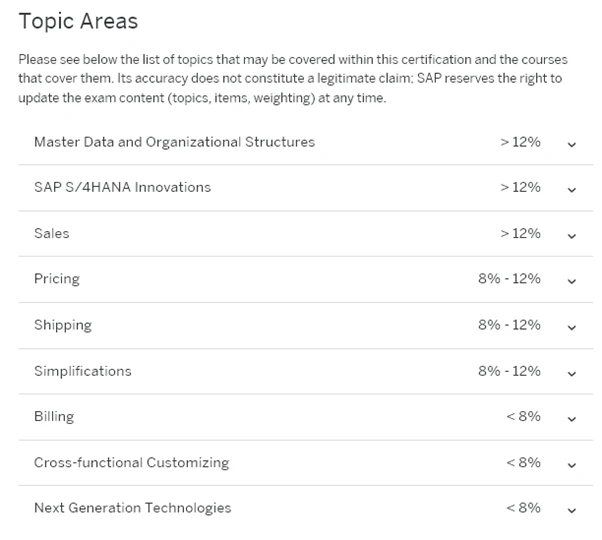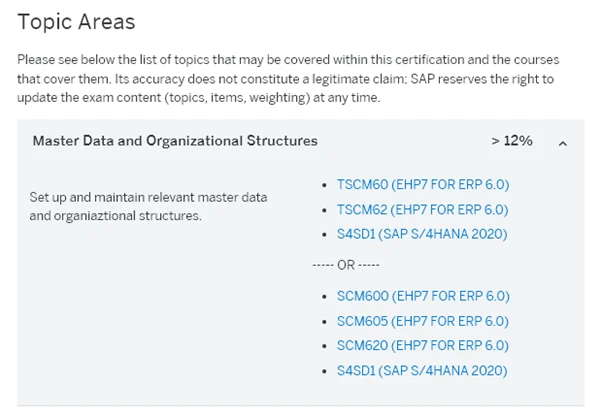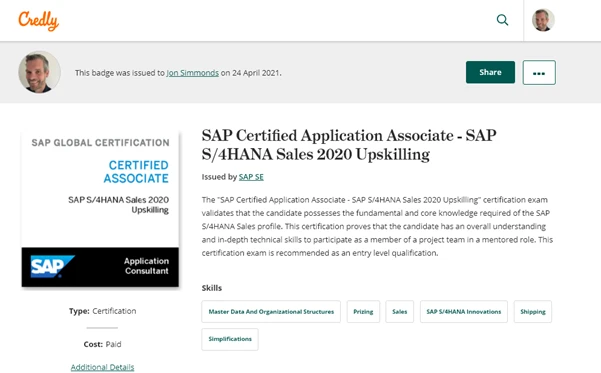An Introduction to SAP Certification Exams - How To Make The Most Of Your SAP Certification Attempt
An Introduction to SAP Certification Exams - How To Make The Most Of Your SAP Certification Attempt.
SAP certification is a sure-fire way of showing employees that you have the necessary and up-to-date skills to be able to contribute effectively to an implementation project.
If you’re looking to get certified in SAP, it’s useful to get some tips on how to make the most of your certification attempt. Here is some background information on how the certification exam process works, with some useful tips on how to get the most out of your experience.
Certification background
Certification exams are based upon an agreed curriculum, which draws upon the certification track delivered in a series of training courses by SAP. If you have attended these training courses (and they can be prohibitively expensive), then the answers to the exam questions will have been addressed somewhere within the courses.
However, if you have not taken the training courses, do not fear. There are a number of other ways to approach a certification exam:
1. Rely upon your experience. If you are a senior SAP consultant, then it is likely that you already have the knowledge required to pass the certification exam in your functional area. This is not to say that you should not study: the exam is carried out under examination conditions, which means you will not have access to an SAP system.
2. Take a look at the topic areas (see below) and identify your “weak spot(s)” and then enrol on those courses – that will keep the cost down.
3. Buy a book! SAP Press have many “SAP Certification Success Guides” directly relating to each exam. The books are extremely good value compared to taking the training, and if you use them correctly they are an invaluable tool, written by authors who have already sat and passed the exams.
Topic areas for the exam can be found, along with ten (very useful) sample questions, the “cut” score (the minimum score for passing), and the duration of the exam, on the training.sap.com site for the certification in question. For example, for the SAP S/4HANA Sales 2020 Upskilling certification, the site here shows as follows:

The topic areas and descriptions are found on the same page:

By opening up the drop-down links shown (as seen below), you can see the training courses which are related to the topic areas in question.

A further drill-down of the courses (see below) will show you the content covered by the course – which is very useful to ensure that you know the exact topics which will be tested.

How to sit the exam
Currently (during the pandemic) online exams are the preferred method. There are currently two methods to taking these exams:
1. One attempt – this is a single, one-off fee for one attempt at the exam.
2. Certification Hub subscription – this is a subscription which allows six attempts at any certification exam within a 12-month period. Your subscription is valid for all available exams in the Certification Hub and you can take the same exam up to a maximum of three times in that period.
The format of the online exam is extremely flexible – times can be chosen from a 24/7 calendar at extremely short notice. You will need a dedicated quiet work area from which to take the exam, your own laptop with integrated webcam and a clear desk. To ensure the integrity of the certification, the exam will be fully proctored, and the proctor will need to be able to see you via webcam for the duration. You will receive instructions in advance of the exam, which will include downloading a secure browser called Questionmark. You will need a photo ID to show the proctor and the proctor will also expect you to show them your entire working area, so be sure to clear away any notebooks.
Once the certification exam is completed, either online or at a certification centre, you will receive the result immediately upon submitting your finalised answers. Successful examinees receive an SAP Global Certification digital badge for their accomplishment.
Exam format
Most certification exams for SAP follow the same format as below.
• Length of exam: Up to three hours.
• Exam questions: Eighty questions, either multiple choice or multiple selection.
• Exam location: Can be taken either at a certification centre or online.
The questions are comprised of the following type:
• Multiple choice, for which you must select one correct answer from the available options.
• Multiple select (type 1), for which you must select the two correct answers out of the four available options.
• Multiple select (type 2), for which you must select the three correct answers out of the five available options.
For the multiple select questions, you will be told how many correct answers there should be.
There are no other question types than these. Note that you must get all the answers correct for the question in order for the question to be considered correctly answered. Incorrect answers will NOT detract from your score and therefore it is important to answer every question, even if your answer is an educated guess only.
The questions will be presented to you in a randomised order, so topics are mixed up throughout the exam.
Typically, the percentage pass rate may change year on year for the certification, depending upon the perceived difficulty rating of the exam. Normal pass rates are between 60 and 70%. Once you pass, you will be issued with a digital badge, as seen below, which can be viewed on the website www.credly.com.

A few more tips from experience!
Having sat through many certification exams, I can offer up a few tips to reduce the stress levels:
1. Don’t let the time worry you. Three hours is a long time for 80 questions, and you will probably find you have way too much time.
2. Use your time efficiently. As you will have lots of time in hand, read and re-read the question. This is essential, especially if you are sitting the exam in a language which is not your mother tongue. Every part of the question is important, as is every part of the optional answers.
3. If you have done any training courses, use these for your revision. Especially useful are bulleted lists in the materials – this is a favourite area for questions.
4. If you are unsure of your answer, try eliminating answers you know are incorrect. By the same token, immediately flag answers you know are correct. Sometimes, answers are paired as opposites, meaning if one answer is correct, you know the other is wrong.
Good luck!